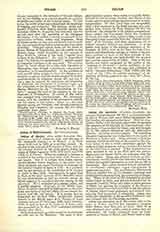

Julian of Speyer, often called JULIANUS TEUTONICUS, a famous composer, poet, and historian of the thirteenth century, b. at Speyer; d. at Paris about 1250 (not in 1285, as is so often stated). He studied at the celebrated University of Paris, and was the musical director at the royal chapel during the reigns of Philip Augustus (1179-1223) and Louis VIII (1223-6) of France. When he resigned to become a member of the newly founded Order of St. Francis is not known. But it is certain that Julian accompanied Brother Simon Angelicus to his native land, when the latter was made Provincial of Germany by the General Chapter of Assisi in 1227. It is probable that he was present at the translation of St. Francis at Assisi in May, 1230. Subsequently he again lived in Paris at the great convent of the Minorites, where he was choir-master as well as corrector mensce (in which capacity he superintended the reading in the refectory). He is renowned as a scholar, artist, and a saintly religious. Although, in the Middle Ages, Julian of Speyer was held in high repute as the composer and writer of rhymed offices, he was almost forgotten until the last decade. It is certain that he composed the rhymed Office (technically termed historia in the Middle Ages) of St. Francis of Assisi (written between February 23, 1229, and October 4, 1235), as well as that of St. Anthony of Padua, who was canonized on May 30, 1232 (composed probably shortly after 1241).
Both these musical, as well as poetical, masterpieces are still used by the Minorites. The acme of liturgical narrative poems, these works are equally distinguished for the harmony, rhythm, and rhyme of the verses, and for their sublime expressiveness as musical compositions. Of their kind they are unequalled. Only a few sentences in the third nocturn (the antiphons) were written by Pope Gregory IX and the cardinals; the remainder is all Julian’s composition. Even outside the Franciscan Order the rhythmic structure has been often copied, whole verses being frequently taken (especially from the “Historia rhythmica” of St. Francis), and these plagiarisms set to Julian’s melodies without any alteration. It is not known how much of the poetical narrative of St. Dominic (d. 1221), used on his feast by both Franciscans and Dominicans, belongs to Julian of Speyer. Some portions at least of the Mass formula of Sts. Francis and Anthony are undoubtedly the musical and poetical composition of Julian. Only in the last decade was Julian recognized as the author of the “Legenda S. Francisci”—partly published in the “Acta SS.”, October, II, 548, and published in full in “Analecta Bollandiana “XI (1902), 160-202—and of the “Vita ab auctore anonymo” of St. Anthony of Padua, printed in the “Acta SS.”, June, II, 705 sqq.
MICHAEL BIHL

